Once you get going, selling on eBay is a simple way to earn some extra cash.
Selling things on the many online “marketplace” platforms (eBay, Etsy, Poshmark, etc.) can be a great way to earn some extra money and get rid of excess stuff around your house
Why you should:
Selling online is an easy source of income (though variable). De-cluttering your space and getting value from things that you no longer need or want can boost your mood and your bottom line.
Why it matters:
Getting rid of things you don’t value, but others do, helps you detach, gives you space and knowledge that others are benefiting from it.
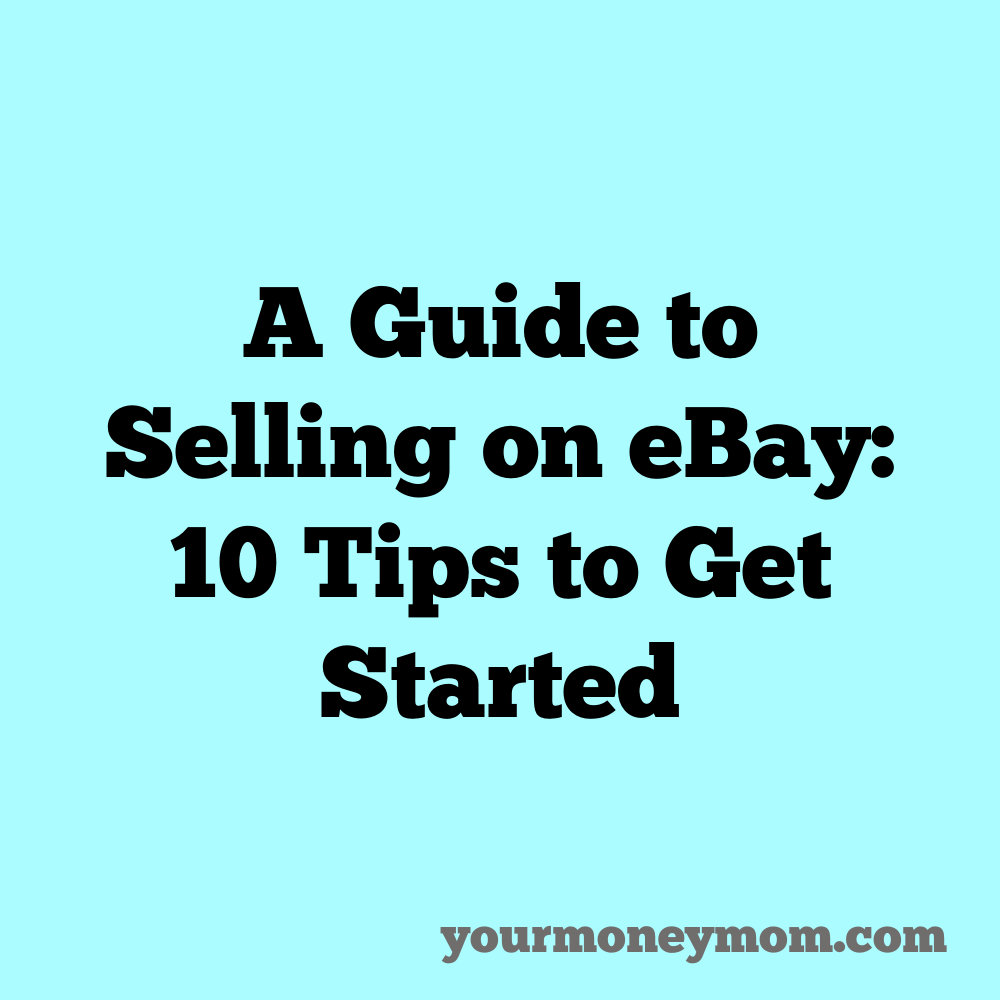
My eBay “journey”
For the last few years, I have been selling things—mostly vintage things from around our house—on eBay.
After we moved houses a few years ago, we gave away—probably literally — tons of things to Goodwill, Salvation Army, and a local charity. There were also quite a few big items, such as furniture, left behind. We gave away some to friends.
But during the move and even after, there were some items that we believed would not be noticed or considered as valuable at either a garage sale or at charities. One example: homeschooling materials. After nearly two decades of home education, we had a lot of resources, books, and programs that we have already used or no longer need, and others would find of value.
(Of course, certain items from homeschooling days I am not parting with—my collection of picture books & other items, and my dog-eared copy of “How To Teach Your Children to Read in 100 Easy Lessons” I will never give up, and I’ve actually used it in volunteering at a local school. But I digress).
That also rang true for some vintage clothes, books, and other items—like magazines, kitchen items, and more.
So I started selling some of these things on eBay. I made a lot of mistakes at first. This shows to me again why it is just good to jump in with a new endeavor, make some mistakes, and get better at it.
Over time, I have gotten savvier and more productive at it. I spend about two hours week either checking eBay, listing things, sending things out, and related tasks.
So much so much so that for tax year 2020, I received tax forms, and I will pay taxes on my net earnings from eBay sales. I also look when I occasionally go to estate sales for items that might be “flippable,” and have turned a profit on almost everything I’ve picked up for a dollar or two.
Here are some tips & ideas. There are doubtless many other “comprehensive” guides to selling on eBay,—and there are so.many. people who make a living going to garage sales, stores, and Goodwills to source items. Google “garage sale flipping” or “eBay sellers” and you will found countless videos, articles, and more.
But if you are relatively new to online selling, are interested in learning the basics of eBay (that you can apply to other online selling portals), or just want to get rid of some things around your house, you will find this guide helpful.
10 guidelines for selling on eBay (that you can apply to other platforms).
Know that these are my personal preferences, and you can certainly decide to do it a different way. (For instance, I do not list things on “auction,” but you might have the time or inclination for that). I want my eBay selling to be as easy and time-efficient as possible. Maybe you do too.
Tip 1: Beware of scammers.
This is especially true as a newer seller. Buyers will contact you through eBay (or your platform), and ask to buy something “off platform,” or ask for weird conditions. It still happens to me occasionally, but it’s much more common for new sellers.
Signs of a scammer:
*someone who wants to do business outside of eBay.
*someone who wants to pay in a different way.
*(possibly) someone who wants you to send the item, after the sale, to a different address.
Basically, anything that makes you think “that’s odd,” you should probably ignore that buyer.
Bonus rookie mistake: sending out your item before the buyer pays for it. Every once in a while (maybe one out of every 25), the buyer never pays. Eventually eBay will close out the case, but if you’ve already sent the item, you have little leverage.
Tip 2: Research sold “comps” before you list.
This is a great way to get a feel for if something sells, and if so, for roughly how much.
Let’s say you came across a LL Bean flannel shirt. In the search box at the top of any eBay page, search for “LL Bean flannel shirt.”
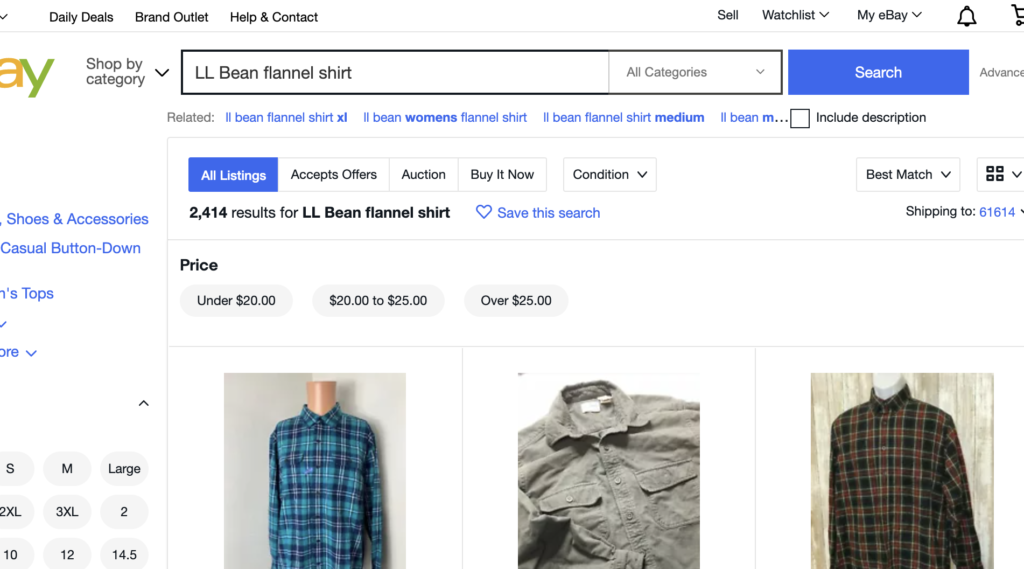
You’ll get a lot of current listings, but you want to know how much they have sold for recently. That’s the “comp” or comparable sale.
On the left-hand column, there’s a way to sort for size, color, and more. There’s also a box you can click (scroll down for it) to display “sold.”
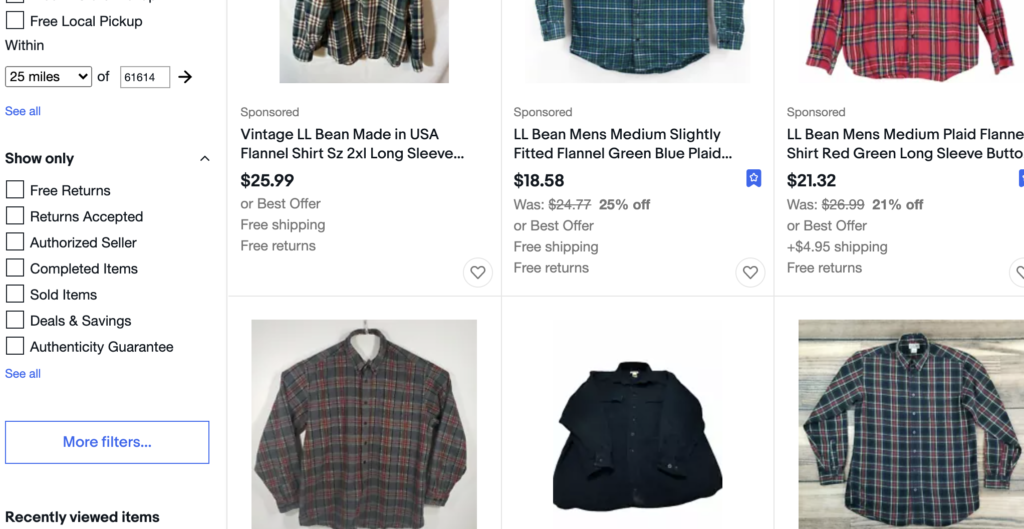
Now you’re going to see not just what something is selling for, but what it truly has sold for recently.
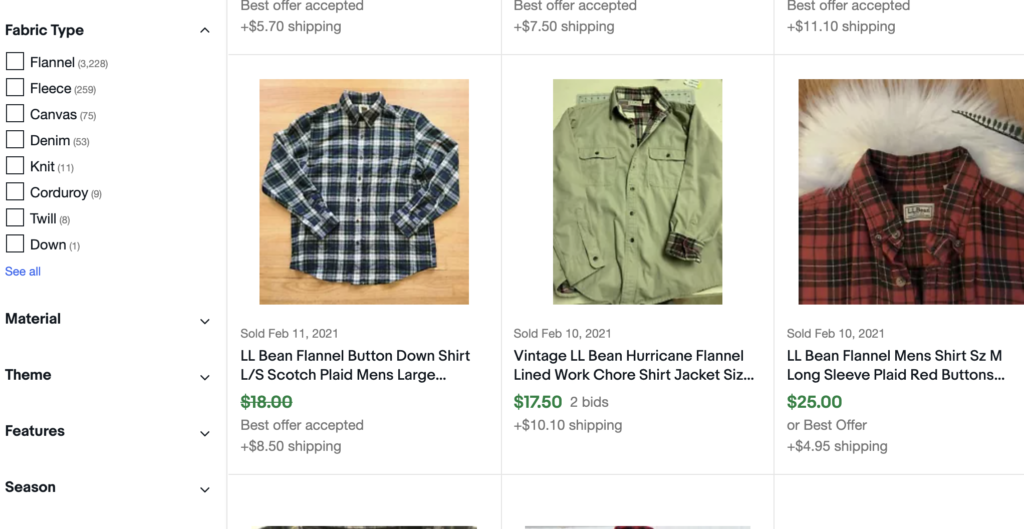
There are more sold listings than current sale listings.
You can save time in putting together your listing by finding a listing of your exact item or similar. Here, I’ve clicked on a “sold listing,” and I can choose “sell one like this,” which will create a draft with much of the information. Be sure to change anything, such as color, size, etc. so your listing is correct.
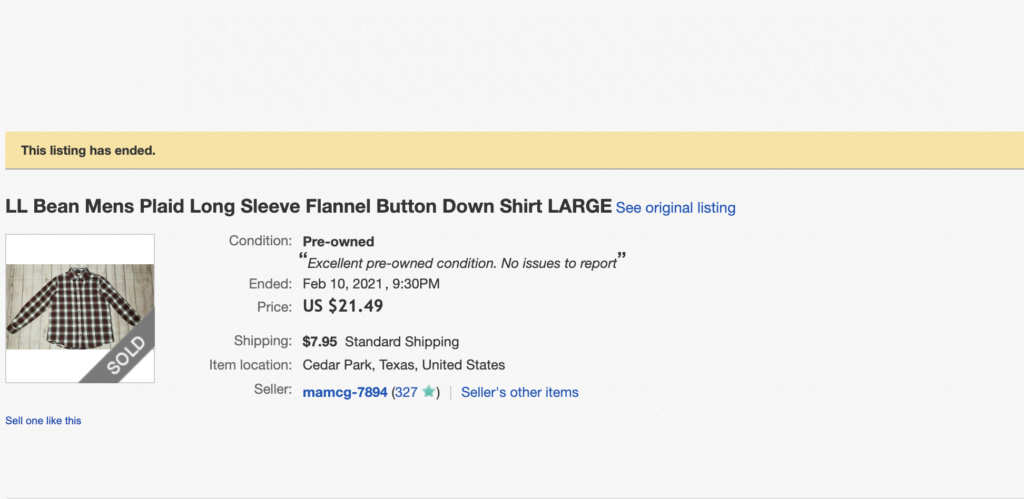

This can be edited with your information & specifics. You can easily add photos. (easiest on your phone).
See how it creates a listing already? To list the shirt, all that is needed is to edit the listing to fill the specifics and shipping information.
Tip 3: Take good photos, but don’t go crazy.
If you follow eBay sellers, often one of the top tips is to take excellent photos. Now while some people post a lot of really poor photos of items for sale on eBay, perhaps reducing their sales or sales prices, you don’t have to get fancy. Just take the best photos you can (I use my iPhone) and call it a day.
I try to take photos on a sunny day, in a sunny room, on a neutral-looking floor (like a wood floor), or a blank wall.
Tip 4: Measure and weigh items before listing to help get an accurate shipping cost (and round up).
When you list an item on eBay, you also enter a package size, weight, and ways that you will ship an item. For books & magazines, I choose USPS media mail, but otherwise I almost always choose USPS Priority Mail. It runs a little more, but it usually arrives faster.
Buyers also receive discounts on shipping. Here’s how it works: if eBay charge a buyer something like $10 for shipping, the seller only pay perhaps $8. It’s a nice little discount, and can often pay for your eBay seller fees.
Typically, as I list an item, I will weigh it on a scale I (eventually) purchased for this purpose. I use it also in the kitchen often, so it was a useful buy in other ways, too! Then I round up a pound or two (depending on the dimensions of the item) for the box & packaging). This ensures I am not paying too much for shipping.
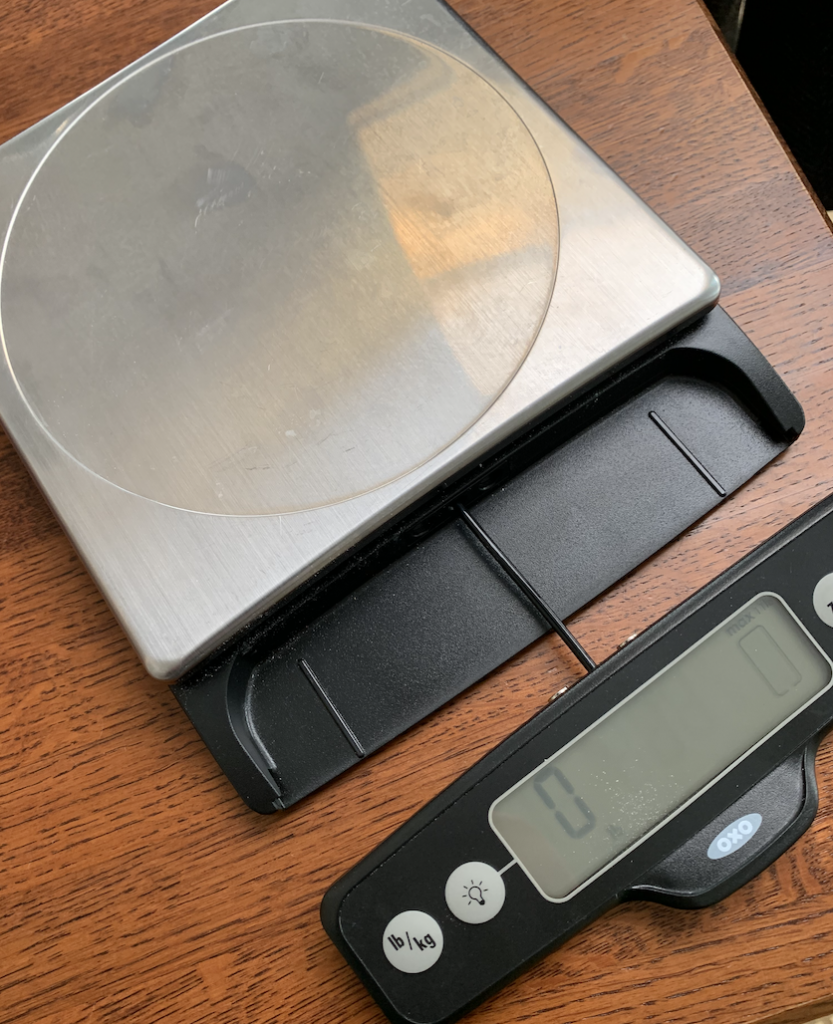
I cannot find a listing for the scale that I purchased, but here is one that is similar.
For something more valuable, or that I couldn’t pack easily, I take the item to UPS. For a small extra charge, UPS will pack it up and ship it for you. This worked well when I sold a pair of kids cross-country skis, but did not have a box big enough. I would also use UPS for fragile, more expensive items.
Tip 5: List “Buy it Now” rather than auctions. Allow offers. Send offers.
EBay started as an auction site, but it’s much more common (and easier) to list an item as “Buy it Now.” Once you figure out a fair price, and can wait until it sells, offer things for a fixed price.
You can also allow “offers” (and set parameters for that, automatically rejecting low-ball offers). I do this, and find that it helps things sell a little more quickly.
Periodically, eBay will offer you the ability to “send an offer” to interested buyers. Someone may have “watched” the item or tagged it. I always “send offers,” and it leads to more sales.
Once you have sold a certain amount and have a good rating, eBay also offers you the opportunity to “promote” your listing. You only have to pay if the item sells, but eBay will put your listing to the top of results if you do this. I take advantage of this. My profits are less, but I am more interested in getting things out of my house than obtaining top dollar.
Tip 6: Keep things listed or for sale in a dedicated closet or area.
I keep almost everything on some shelving units in our basement. One section is books, and I try to keep all the men’s shoes together, the women’s shoes together, etc. I also have bulkier hanging items in an unused closet. That helps me find things quickly.
I also keep a lot of boxes and packing materials. Online delivery boxes and packages are great to repurpose this way.
Tip 7: Check eBay on a regular schedule—daily is best.
Checking eBay is part of my morning routine. If there is a sale, I will either pack it up right then, or make a mental note to do so later in the day. eBay allows three days to send off items, but I find packing them up the day they sell is best practice, and often people will rate you highly for shipping speed.
Tip 8: If you sell regularly, consider a “store” account.
A store account on eBay (I have a “starter” store, about $5/month) allows several advantages. At the lowest level—Starter—you do not save on the fees you owe eBay when an item sells, but you can list more items.
Without a store, you can only list 200 items per month. That seems like plenty, and yet, if you list items over time, you might have over 200 items listed at one time. Since they will “re-list” every month, eBay will charge you for each “insertion” over that 200. The limit for non-store sellers was 50 items when I started, so it made sense to pay for a store so that I would not have to worry about re-listing fees.
Having an eBay store also allows you to put your listings “on vacation” when you’re away. It’s called–shockingly– vacation mode.
If you do not have an eBay store, you either have to hope nothing sells while you are away, or end all of your listings. That is because if you do not sending out sold items in a timely manner, eBay lowers your ratings.
If you have an eBay store, you can put all of your listings automatically on “away mode” so people cannot buy, or will get a notice that the store owner is away and an item would not be sent out for x number of days.
Tip 9: Keep Track of Your Sales
eBay allows you to print off reports of your sales over three-month periods, but it’s also a good idea to have a simple spreadsheet to keep track of your sales, so you know what you have sold.
Tip 10: (Maybe) focus on one platform.
There are many, many online marketplaces for selling. Choosing the right one for you is important and a savvy move.
Some sellers “cross-post,” meaning they list items on several marketplaces, such as on Poshmark and eBay.
But it is advisable to stick to one platform, especially when you are getting started.
For instance, one of my kids sells her unwanted clothing on Poshmark, and she likes the interface, the free shipping (Poshmark counts that in the fee they take), and more. Others sell physical and vintage goods on Etsy.
All of those online marketplaces have pros and cons, depending on what you want to sell, how you want the process to work, and more.
Using one platform also simplifies your record-keeping.
A few resources for online selling
I have found the following to be helpful: articles, YouTube channels, and items to have on hand.
I happened upon these articles and YouTubers over time, and I have found them to be solid sources of information. Just know that if you have a question, you can Google it and usually find a YouTube video or online article. For instance, when I needed to know how to measure or describe a men’s jacket, online sources are super helpful. (This one https://www.suitupp.com/pages/suit_sizing
And this one: https://propercloth.com/reference/measure-tailored-suit-jackets-sport-coats/chest)
As mentioned above, I re-use boxes & packages, but having multi-packs of Scotch mailing tape on hand is ideal.
A scale is helpful for mailing, and you can also use it in the kitchen.
Ashley has engaging videos. I can’t remember why I started following her, but she will have videos sharing brands that sell well, which I keep in mind if I happen to be at an estate sale or garage sale.
Not every CPA is equipped to give advice or understand how online business works. Mark Tew is a CPA who understands online selling, since he sells online and works in this space.
Because eBay sales and tax rules have gotten more complicated, I purchased his course, Reseller Tax Academy, and it is very worthwhile. If you do get more serious about selling online, consider purchasing this course.
Your turn: have you sold things on eBay or another platform? What are some of your tips?

